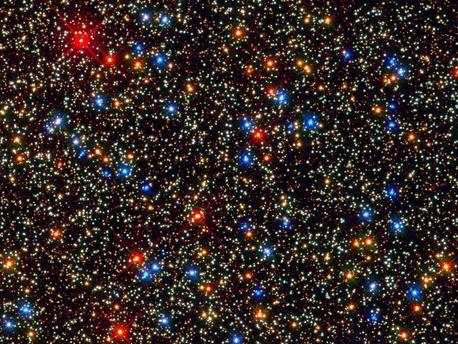Stellar Evolution
Milky Way's building blocks still sparkle in the sky
They are glittering baubles in the sky. Now it seems that globular clusters of stars may be remnants of small galaxies that merged to form the Milky Way.
 © NASA/ESA/Hubble SM4 ERO Team |
Complex globular clusters like Omega Centauri may be remnants of entire dwarf galaxies.
More than 150 globular clusters are known of. Most were thought to have a simple make-up, with all their stars formed of the same primordial mixture of hydrogen and helium gas. Only a few clusters, such as Omega Centauri, seemed more complex.
Jae-Woo Lee of Sejong university in Seoul, South Korea, and his colleagues re-examined 37 of the clusters, and found that more than half of them hold two distinct populations of stars. One population seems to have more complex chemistry than the other, containing high levels of calcium.
This calcium and other heavy elements could have been created in supernova explosions, and then incorporated into new stars, but the clusters as they are today are too small to keep hold of the material violently thrown out by supernovae. This suggests that the clusters are the remnants of entire dwarf galaxies.
original source (for full reading needs nature-login): Nature
Jae-Woo Lee of Sejong university in Seoul, South Korea, and his colleagues re-examined 37 of the clusters, and found that more than half of them hold two distinct populations of stars. One population seems to have more complex chemistry than the other, containing high levels of calcium.
This calcium and other heavy elements could have been created in supernova explosions, and then incorporated into new stars, but the clusters as they are today are too small to keep hold of the material violently thrown out by supernovae. This suggests that the clusters are the remnants of entire dwarf galaxies.
original source (for full reading needs nature-login): Nature
Stellar Evolution
Milky Way's building blocks still sparkle in the sky
They are glittering baubles in the sky. Now it seems that globular clusters of stars may be remnants of small galaxies that merged to form the Milky Way.
 © NASA/ESA/Hubble SM4 ERO Team |
Complex globular clusters like Omega Centauri may be remnants of entire dwarf galaxies.
More than 150 globular clusters are known of. Most were thought to have a simple make-up, with all their stars formed of the same primordial mixture of hydrogen and helium gas. Only a few clusters, such as Omega Centauri, seemed more complex.
Jae-Woo Lee of Sejong university in Seoul, South Korea, and his colleagues re-examined 37 of the clusters, and found that more than half of them hold two distinct populations of stars. One population seems to have more complex chemistry than the other, containing high levels of calcium.
This calcium and other heavy elements could have been created in supernova explosions, and then incorporated into new stars, but the clusters as they are today are too small to keep hold of the material violently thrown out by supernovae. This suggests that the clusters are the remnants of entire dwarf galaxies.
original source (for full reading needs nature-login): Nature
Jae-Woo Lee of Sejong university in Seoul, South Korea, and his colleagues re-examined 37 of the clusters, and found that more than half of them hold two distinct populations of stars. One population seems to have more complex chemistry than the other, containing high levels of calcium.
This calcium and other heavy elements could have been created in supernova explosions, and then incorporated into new stars, but the clusters as they are today are too small to keep hold of the material violently thrown out by supernovae. This suggests that the clusters are the remnants of entire dwarf galaxies.
original source (for full reading needs nature-login): Nature





